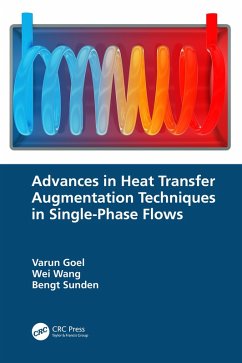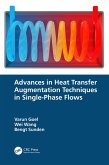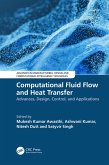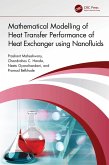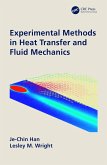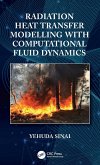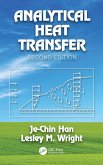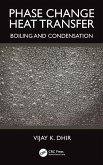Advances in Heat Transfer Augmentation Techniques in Single-Phase Flows (eBook, PDF)


Alle Infos zum eBook verschenken

Advances in Heat Transfer Augmentation Techniques in Single-Phase Flows (eBook, PDF)
- Format: PDF
- Merkliste
- Auf die Merkliste
- Bewerten Bewerten
- Teilen
- Produkt teilen
- Produkterinnerung
- Produkterinnerung

Hier können Sie sich einloggen

Bitte loggen Sie sich zunächst in Ihr Kundenkonto ein oder registrieren Sie sich bei bücher.de, um das eBook-Abo tolino select nutzen zu können.
Augmentation of heat transfer is important in energy conservation and developing sustainable energy systems. This book provides the science necessary to understand the basics of heat transfer augmentation in single-phase engineering systems. It considers theory and practice including computational and experimental procedures, evaluation techniques for performance, and new trends. Several applications of augmentation methods like surface modification, introduction of vortex flow and impinging jets, opportunities of ultrasound and magnetic fields, pulsatile flows, heat exchangers, and nanofluids…mehr
- Geräte: PC
- mit Kopierschutz
- eBook Hilfe
![Advances in Heat Transfer Augmentation Techniques in Single-Phase Flows (eBook, ePUB) Advances in Heat Transfer Augmentation Techniques in Single-Phase Flows (eBook, ePUB)]() Varun GoelAdvances in Heat Transfer Augmentation Techniques in Single-Phase Flows (eBook, ePUB)49,95 €
Varun GoelAdvances in Heat Transfer Augmentation Techniques in Single-Phase Flows (eBook, ePUB)49,95 €![Computational Fluid Flow and Heat Transfer (eBook, PDF) Computational Fluid Flow and Heat Transfer (eBook, PDF)]() Computational Fluid Flow and Heat Transfer (eBook, PDF)64,95 €
Computational Fluid Flow and Heat Transfer (eBook, PDF)64,95 €![Mathematical Modelling of Heat Transfer Performance of Heat Exchanger using Nanofluids (eBook, PDF) Mathematical Modelling of Heat Transfer Performance of Heat Exchanger using Nanofluids (eBook, PDF)]() Prashant MaheshwaryMathematical Modelling of Heat Transfer Performance of Heat Exchanger using Nanofluids (eBook, PDF)45,95 €
Prashant MaheshwaryMathematical Modelling of Heat Transfer Performance of Heat Exchanger using Nanofluids (eBook, PDF)45,95 €![Experimental Methods in Heat Transfer and Fluid Mechanics (eBook, PDF) Experimental Methods in Heat Transfer and Fluid Mechanics (eBook, PDF)]() Je-Chin HanExperimental Methods in Heat Transfer and Fluid Mechanics (eBook, PDF)42,95 €
Je-Chin HanExperimental Methods in Heat Transfer and Fluid Mechanics (eBook, PDF)42,95 €![Radiation Heat Transfer Modelling with Computational Fluid Dynamics (eBook, PDF) Radiation Heat Transfer Modelling with Computational Fluid Dynamics (eBook, PDF)]() Yehuda SinaiRadiation Heat Transfer Modelling with Computational Fluid Dynamics (eBook, PDF)44,95 €
Yehuda SinaiRadiation Heat Transfer Modelling with Computational Fluid Dynamics (eBook, PDF)44,95 €![Analytical Heat Transfer (eBook, PDF) Analytical Heat Transfer (eBook, PDF)]() Je-Chin HanAnalytical Heat Transfer (eBook, PDF)82,95 €
Je-Chin HanAnalytical Heat Transfer (eBook, PDF)82,95 €![Phase Change Heat Transfer (eBook, PDF) Phase Change Heat Transfer (eBook, PDF)]() Vijay K. DhirPhase Change Heat Transfer (eBook, PDF)118,95 €
Vijay K. DhirPhase Change Heat Transfer (eBook, PDF)118,95 €-
-
-
Key features:
- Provides the fundamental science needed to understand and further develop heat transfer augmentation for future energy systems
- Give examples of how ultrasound and magnetic fields, vortex flow, impinging jets, surface modification and nanofluids can augment heat transfer
- Considers basic issues of computational and experimental methods for analysis, design, and evaluation of efficient and sustainable heat transfer
It is an ideal reference text for graduate students and academic researchers working in the fields of mechanical, aerospace, industrial, manufacturing, and chemical engineering.
Dieser Download kann aus rechtlichen Gründen nur mit Rechnungsadresse in A, B, BG, CY, CZ, D, DK, EW, E, FIN, F, GR, HR, H, IRL, I, LT, L, LR, M, NL, PL, P, R, S, SLO, SK ausgeliefert werden.
- Produktdetails
- Verlag: Taylor & Francis eBooks
- Seitenzahl: 308
- Erscheinungstermin: 26. Januar 2024
- Englisch
- ISBN-13: 9781003829584
- Artikelnr.: 69600580
- Verlag: Taylor & Francis eBooks
- Seitenzahl: 308
- Erscheinungstermin: 26. Januar 2024
- Englisch
- ISBN-13: 9781003829584
- Artikelnr.: 69600580
- Herstellerkennzeichnung Die Herstellerinformationen sind derzeit nicht verfügbar.
Wei Wang received his Ph.D. in Engineering Thermophysics 2019, and became an associate professor in School of Energy Engineering and Science at 2022, all from Harbin Institute of Technology, Harbin, China. He was visiting study at Lund University and learn from Professor Bengt Sunden, at Lund, Sweden in 2017-2018. His research activities include enhancement of heat transfer, heat dissipation in aerospace and electronics, heat and mass transfer in evaporation and condensation, and compact heat exchangers design.
Bengt Sunden received his M.Sc. in 1973, Ph.D. in 1979 and became Docent in 1980, all from Chalmers University of Technology, Gothenburg, Sweden. He was appointed Professor of Heat Transfer at Lund University, Lund, Sweden in 1992 and served as Head of the Department of Energy Sciences, Lund University for 21 years, 1995-2016. He has edited 35 books and authored three major textbooks. He has published about 650 papers in well-established and highly ranked scientific journals. From Scopus, the h-index is 59 and the number of citations is more than 16500
Mechanisms of heat transfer. 1.3. Introduction to heat exchangers.
References. Chapter 2. Heat Transfer Augmentation. 2.1. Introduction. 2.2.
Techniques for augmentation. 2.3. Evaluation criteria. 2.4. Published
literature. 2.5. Patents. 2.6. Conclusions. References. Chapter 3. Using
Surface Modification. 3.1. Introduction. 3.2. Finned surface. 3.3.
Corrugated surface. 3.4. Coiled surface. 3.5. Modified surface. 3.6.
Summary and outlook. References. Chapter 4. Heat Transfer Augmentation
using Vortex Flow. 4.1. Introduction. 4.2. Surface vortex generator. 4.3.
Insert vortex generator. 4.4. Summary and outlook. References. Chapter 5.
Heat Transfer Augmentation using Pulsatile Flows. 5.1. Introduction. 5.2.
Important dimensionless numbers. 5.3. Pulsating flow. 5.4. Single-phase
pulsation flow heat transfer enhancement. 5.5. Pulsating flow around a
cylinder. 5.6. Reciprocating flow. 5.7. Single-phase pulsating flow and
porous media. 5.8. Pulsating nanofluid flow. 5.9. Pulsating flow around
ribs. 5.10. Conclusions. References. Chapter 6. Heat Transfer Augmentation
using Ultrasound and Magnetic Forces. 6.1. Introduction. 6.2. Mechanisms.
6.3. Results. 6.4. Conclusions. References. Chapter 7. Heat Transfer
Augmentation using Jet Impingement. 7.1. Introduction. 7.2. Mechanism. 7.3.
Investigated parameters. 7.4. Studied Geometries. 7.5. Results. 7.6.
Excited Jets. 7.7. Nanofluids. 7.8. Phase change materials. 7.9.
Conclusions. References. Chapter 8. Heat Transfer Augmentation using
Nanofluids. 8.1. Introduction. 8.2. Preparation and stability. 8.3.
Thermophysical properties. 8.4. Applications and challenges. References.
Chapter 9. Performance Evaluation Methods for Different Heat Transfer
Techniques. 9.1. Introduction. 9.2. Performance assessment based on the
first law of thermodynamics. 9.3. Performance assessment based on the
second law of thermodynamics. 9.4. Multi-objective optimization and
evaluation. 9.5. Conclusions and outlook. References. Chapter 10. Heat
Transfer Measurement Techniques. 10.1. Introduction. 10.2. Infrared
imaging, IR. 10.3. Liquid crystal thermography, LCT. 10.4. Thermocouples,
TCs. 10.5. Naphthalene sublimation technique. 10.6. Pressure sensitive
paint technique. 10.7. Particle image velocimetry, PIV. 10.8. Hot-wire
anemometry. 10.9. Uncertainty analysis in measurements. References. Chapter
11. Computational Methods used in Heat Transfer. 11.1. Introduction. 11.2.
Governing equations. 11.3. On numerical methods to solve partial
differential equations. 11.4. The CFD approach. 11.5. Advanced topics not
treated. 11.6. Examples. 11.7. Conclusions. References.
Mechanisms of heat transfer. 1.3. Introduction to heat exchangers.
References. Chapter 2. Heat Transfer Augmentation. 2.1. Introduction. 2.2.
Techniques for augmentation. 2.3. Evaluation criteria. 2.4. Published
literature. 2.5. Patents. 2.6. Conclusions. References. Chapter 3. Using
Surface Modification. 3.1. Introduction. 3.2. Finned surface. 3.3.
Corrugated surface. 3.4. Coiled surface. 3.5. Modified surface. 3.6.
Summary and outlook. References. Chapter 4. Heat Transfer Augmentation
using Vortex Flow. 4.1. Introduction. 4.2. Surface vortex generator. 4.3.
Insert vortex generator. 4.4. Summary and outlook. References. Chapter 5.
Heat Transfer Augmentation using Pulsatile Flows. 5.1. Introduction. 5.2.
Important dimensionless numbers. 5.3. Pulsating flow. 5.4. Single-phase
pulsation flow heat transfer enhancement. 5.5. Pulsating flow around a
cylinder. 5.6. Reciprocating flow. 5.7. Single-phase pulsating flow and
porous media. 5.8. Pulsating nanofluid flow. 5.9. Pulsating flow around
ribs. 5.10. Conclusions. References. Chapter 6. Heat Transfer Augmentation
using Ultrasound and Magnetic Forces. 6.1. Introduction. 6.2. Mechanisms.
6.3. Results. 6.4. Conclusions. References. Chapter 7. Heat Transfer
Augmentation using Jet Impingement. 7.1. Introduction. 7.2. Mechanism. 7.3.
Investigated parameters. 7.4. Studied Geometries. 7.5. Results. 7.6.
Excited Jets. 7.7. Nanofluids. 7.8. Phase change materials. 7.9.
Conclusions. References. Chapter 8. Heat Transfer Augmentation using
Nanofluids. 8.1. Introduction. 8.2. Preparation and stability. 8.3.
Thermophysical properties. 8.4. Applications and challenges. References.
Chapter 9. Performance Evaluation Methods for Different Heat Transfer
Techniques. 9.1. Introduction. 9.2. Performance assessment based on the
first law of thermodynamics. 9.3. Performance assessment based on the
second law of thermodynamics. 9.4. Multi-objective optimization and
evaluation. 9.5. Conclusions and outlook. References. Chapter 10. Heat
Transfer Measurement Techniques. 10.1. Introduction. 10.2. Infrared
imaging, IR. 10.3. Liquid crystal thermography, LCT. 10.4. Thermocouples,
TCs. 10.5. Naphthalene sublimation technique. 10.6. Pressure sensitive
paint technique. 10.7. Particle image velocimetry, PIV. 10.8. Hot-wire
anemometry. 10.9. Uncertainty analysis in measurements. References. Chapter
11. Computational Methods used in Heat Transfer. 11.1. Introduction. 11.2.
Governing equations. 11.3. On numerical methods to solve partial
differential equations. 11.4. The CFD approach. 11.5. Advanced topics not
treated. 11.6. Examples. 11.7. Conclusions. References.
